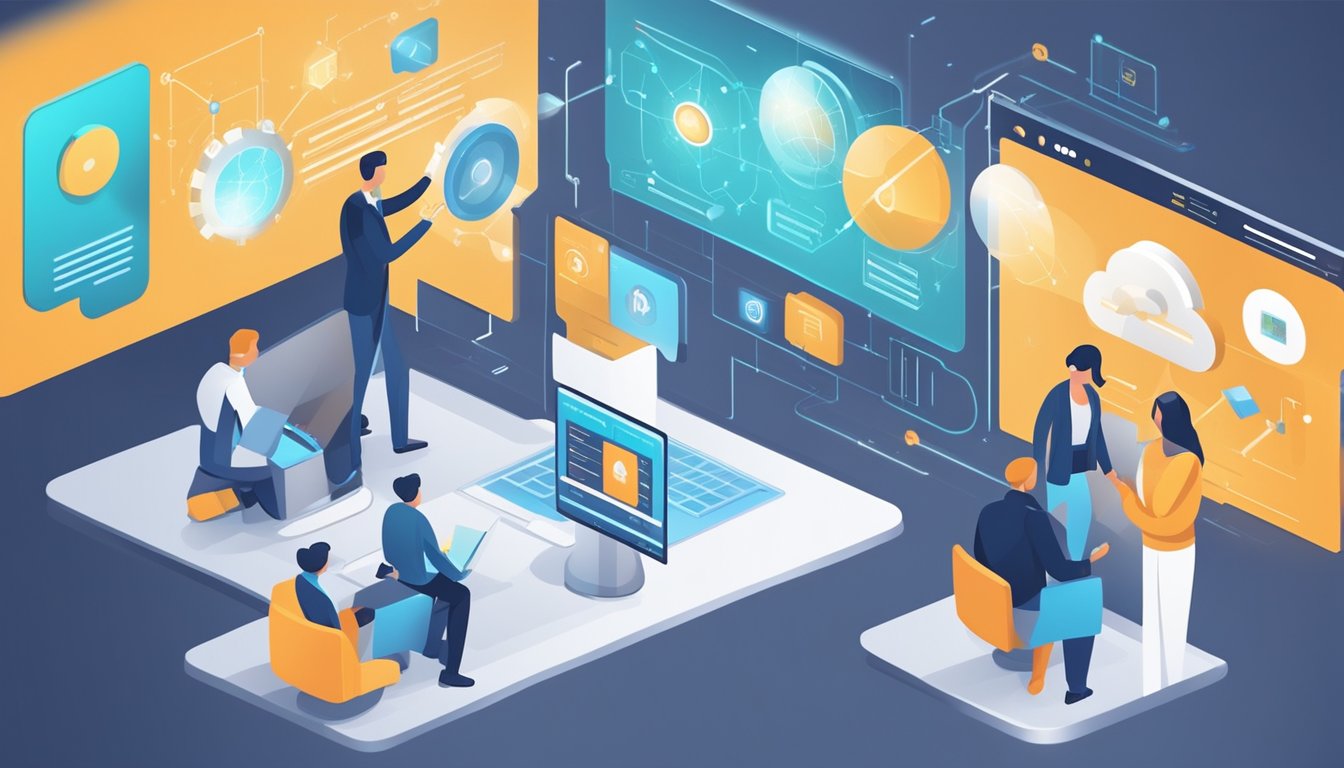Strategies for Adopting AI in Traditional Businesses
As traditional businesses wade into the digital waters, the prospect of integrating artificial intelligence (AI) might feel like navigating uncharted territory. You’ve probably heard the buzz about AI revolutionizing industries, transforming customer experiences, and providing a hefty competitive advantage. But let’s be real, the mere mention of technology and innovation can make even the savviest execs break into a sweat. So, how do you start adopting AI without getting lost in a sea of algorithms and data models?

Think of AI as your secret weapon for staying ahead of the curve. It’s not just for tech giants and startups; AI can be the ace up the sleeve for your traditional business too. Imagine cutting down on tedious tasks and focusing on what matters—growing your business and delighting your customers. We’re talking about smart automation that handles the grunt work, analytics that offer razor-sharp insights, and customer service tools that anticipate needs before your clients even articulate them.
Now, before you jump on the AI bandwagon, let’s huddle up and tackle the game plan. Employing AI is not simply about picking out the flashiest tech. It’s about understanding the unique needs of your business, the problems you’re itching to solve, and how AI can be harnessed to address these challenges effectively. There’s a lot to unpack when it comes to implementing AI, but with the right strategies, your business can benefit from increased efficiency, cost savings, and yes, that sweet competitive edge. Ready to power up your traditional business with a splash of AI innovation? Let’s dive in!
Understanding AI and Its Impact on Business
Welcome to the exciting intersection where traditional business meets futuristic tech! You’re about to uncover how artificial intelligence (AI) isn’t just for the sci-fi movies; it’s reshaping the world of commerce right before our eyes.
The Basics of AI and Machine Learning
Ever wondered at the magic behind Siri’s ability to understand you or how your Facebook feed always seems to know what you’ll like? That’s the power of AI and machine learning at work. Basically, artificial intelligence refers to computers programmed to think like humans and even improve over time. It’s like teaching a child through experience, but at lightning speed. Machine learning is a subsection here – think of it as the method of teaching, which allows the AI to get smarter as it ‘learns’ from data.
AI operates on patterns and predictions. Using algorithms, these machines can recognize patterns faster and more accurately than any human. That’s why businesses are harnessing AI to boost efficiency and streamline operations.
How AI Is Changing the Business Landscape
Let’s talk about change and how AI is the biggest game-changer in town. Whether it’s through automation, where repetitive tasks are handed off to tireless bots, or advanced data analysis that can predict market trends, businesses are getting an upgrade. This isn’t just about cutting costs or speeding things up, though those are great benefits. We’re talking about a disruption in the traditional business model, leading to innovation like never before.
Imagine having an assistant that never sleeps, never errs, and continually evolves to work better. That’s AI for you – it’s like the superhero sidekick for any business that wants to stay competitive in a quickly evolving market, as illustrated by the diversity of AI startups in various industries from a study highlighted in ScienceDirect.
From personalized customer experiences that feel like a warm handshake to smart supply chains that know when to restock your shelves, AI is the silent powerhouse behind today’s business growth. And the best part? It’s just getting started.
So, have you started imagining how AI could transform your business yet?
Developing a Strategic Approach to AI Adoption
Before diving headfirst into the world of artificial intelligence, you need a solid game plan. Think of AI as a high-powered engine for your business; to harness its full potential effectively, you certainly need to fine-tune your strategy.
Assessing Your Business’s Readiness for AI
Are you revved up and ready to welcome AI with open arms? It’s like preparing for a marathon; you wouldn’t run without the right gear, right? Let’s break down what you need to check off your list before bringing AI onboard:
- Leadership Buy-In: Is your C-suite on board? Getting a thumbs-up from the top brass means having champions who understand the value and risks associated with AI.
- Technical Infrastructure: Do you have the IT horsepower? AI can be a resource hog, so make sure your systems can handle it.
- Data Governance: Got your data ducks in a row? AI thrives on data, the cleaner, the better. Ensure you’ve got a governance strategy to match.
- Skillset Availability: Who’s driving? Assess if your team has the skills to manage and interpret AI, or consider what kind of investment in training or hiring you need to make.
Setting Strategic Goals for AI Integration
Now, let’s talk destination—where is AI taking you? Setting strategic goals for AI isn’t just about dreaming big; it’s about plotting a roadmap with milestones. Here’s what you should focus on:
- Alignment with Business Objectives: Are your AI goals married to your business objectives? Make sure every AI initiative tightly laces into your company’s mission.
- Scalability and Flexibility: Can your AI scale sprints into marathons? The AI solutions you choose should not only meet today’s needs but also grow with your business.
- Risk Management: Ever heard the one about the risk-aware business leader? They mitigated their AI risks so well; they could sleep like a log at night. Jokes aside, understanding potential challenges and having a clear risk management plan is essential.
Remember, adopting AI is not just a tech upgrade; it’s a transformational journey. Make sure your strategic approach to AI adoption is as detailed and thought-out as a roadmap for a cross-country trip – after all, you wouldn’t start driving without knowing the route, would you?
Building an AI-Friendly Infrastructure

When you’re getting your business AI-ready, think of it as setting up a sturdy and secure playground for the tech kids to come and play. You’ve got to invest in the solid swings and slides—essentially the right tech—and make sure the fence around the playground—that’s your data privacy and compliance—is top-notch.
Investing in the Right Technology
Have you ever tried building a house without a hammer and nails? Pretty tough, right? That’s why choosing the right technology for building your AI infrastructure is a no-brainer. You’ll need powerful computers that can process large data sets quickly, and storage solutions that can handle the massive influx of information without breaking a sweat.
- Compute Power: Look for processors specifically designed for AI, like GPUs or TPUs.
- Storage Solutions: SSDs are your best bet for speed, while you might want long-term storage for the nitty-gritty data bits.
- Networking Capabilities: Fiber optics might do the trick for zippy data transfers.
Remember, this tech should not only be powerful but also scalable because as your AI initiatives grow, so will your tech needs.
Ensuring Data Privacy and Compliance
Imagine throwing a party and not telling your guests about the house rules—things could get messy, right? Similarly, in the AI party, it’s crucial to maintain a strict protocol regarding data privacy and compliance. You’ve got to be a good host and protect your guests’ secrets (aka your customers’ data).
- Data Security Tools: Encryption, firewalls, and anti-malware programs are your bouncers against data breaches.
- Privacy Laws: Stay in sync with regulations like GDPR or CCPA; staying informed is staying safe.
Make sure your data privacy policies are not just checked boxes but active shields guarding your business against intrusive eyes. Compliance is not just about avoiding fines, it’s about earning trust. If your customers trust your AI, they’ll trust you.
By focusing on these two foundational areas, your business will be ready to welcome AI with open arms, and the real fun can begin. Remember, the goal is to make AI feel it has found its new home in your business, not just a temporary stay.
Cultivating AI Talent within Your Team

Ready to make AI your team’s sidekick? Let’s groom your crew to wield AI like superheroes in the tech realm. We’re talking Iron Man suits for your business—minus the flying (for now).
The Importance of Training and Development
So, you’re wondering, “Why bother training my team in AI?” Well, let me tell you, fostering AI skills in-house is like giving your team a high-tech upgrade. AI isn’t going anywhere, and companies across the globe are tuning into the tune of a 270 percent increase in AI adoption over four years. Plus, experts predict a spending swell to a cool US$79 billion by 2022 on AI. I bet that number catches your eye!
Seriously, investing in training and development ensures your team stays ahead of the curve. Here’s what you do:
- Identify Key AI Skills: Look for skill gaps and decide what AI chops your team needs.
- Custom Training Programs: Roll out tailored training—workshops, online courses, you name it!
- Continuous Learning Culture: Encourage your team to keep learning. It’s like leveling up in a video game—more skills, more power!
Recruiting AI Experts and Building a Diverse Team
Now, what about bringing in the brainiacs? Recruiting AI talent means you’re bringing in fresh ideas and cutting-edge know-how. But remember, it’s not just about the smarts. Diversity is your secret sauce—a mix of backgrounds, perspectives, and skills can cook up some serious innovation.
When you’re on the hunt for AI pros, think:
- Attractive AI Propositions: Imagine what makes your company a sweet spot for AI gurus. Is it the projects? The tech toys? The promise of making a dent in the universe?
- Skill Mix Mastery: You’ve got to balance your lineup—a blend of seasoned AI talent and bright-eyed rookies can lead to marvelous things.
- Inclusivity Wins: Cast a wide net. Embrace different thinking styles and cultures. It’s not just nice—it’s strategic.
By emphasizing both training your current team and recruiting wisely, you’re setting up shop for an innovation bonanza. Strap in! Your AI-powered business adventure is just beginning.
Leveraging AI for Enhanced Customer Experience

You know how important a solid customer experience is for any business, right? Well, hold onto your digital hats, because AI is transforming customer service in big, exciting ways! Let’s jump in and see how it can make your interactions with customers smoother and more personalized.
Improving Customer Service with AI
Imagine having a helpful assistant available 24/7, answering inquiries, solving problems, and never taking a coffee break. That’s what AI can do for your customer service. AI-driven chatbots are revolutionizing the way businesses handle customer support. They’re fast, they’re efficient, and they learn from each interaction. Here’s the scoop:
- Instant Support: Chatbots provide immediate responses to customer queries, reducing wait times.
- Cost-effective: They can handle a large volume of requests without the need for more staff.
Chatbots might not replace every human interaction just yet, but they’re a game-changer for handling those frequently asked questions.
Personalizing Customer Interactions
You’ve probably heard “personalization” gets thrown around a lot lately, but what does it really mean? It’s about making your customers feel like they’re the only ones in the room. AI crunches data to suggest products, tailor services, and send personalized communications.
- Tailored Recommendations: Based on browsing history and past purchases, AI can suggest items that your customers are more likely to buy.
- Individualized Service: Customer interactions are adapted for each person, making them feel heard and valued.
The bottom line is that AI isn’t here to take over – it’s here to amp up the customer experience and give your business that cutting-edge relevance. And who doesn’t want to be ahead of the curve?
Driving Business Growth and Efficiency with AI

Artificial Intelligence is changing the game for businesses like yours, pushing the boundaries of what’s possible when it comes to growth and efficiency. But how exactly does AI transform these crucial areas? Let’s dive in without any fluff and check out some real, tangible ways you can leverage AI to streamline operations and make better decisions, shall we?
Streamlining Operations with Automation
Imagine cutting the time it takes to manage your inventory in half. That’s not just a daydream—it’s a real possibility with AI-powered automation. AI systems can automatically track and reorder stock, turning what once was a headache into a seamless process.
- Inventory Management: By predicting inventory needs, you never run out of popular items or overstock the duds.
- Productivity: Wave goodbye to manual data entry. Automation means your employees can focus on what humans do best—being creative and strategic.
Harnessing Analytics for Better Decision-Making
Ever felt lost in a sea of data? AI is like the ultimate life raft. It sifts through mountains of information to give you insights you can actually use.
- Analytics: AI tools analyze past sales data to forecast future trends, helping you stay ahead of the curve.
- Decision-Making: With clearer insights, your decisions are grounded in data, not just gut feelings.
By integrating AI into your business operations, you’re not just keeping up with the times; you’re setting your business up for unprecedented growth and efficiency. Now, isn’t that a step worth taking?
Innovating Products and Services through AI
Ever wondered how companies take their products from “meh” to “wow”? The secret sauce is often AI! Let’s dive into how artificial intelligence can catapult your products and services to the next level of innovation and creativity.
AI in New Product Development
Have you ever dreamed of having a creative genius at your beck and call, brainstorming the next big thing for your business? Well, AI is that genius! Siemens, for example, took collaboration to new heights by creating an industrial co-pilot, drastically reducing simulation times and transforming tasks from taking weeks down to just minutes. They show us that integrating AI into product development is like having a turbo boost for innovation.
AI tools can:
- Assess vast amounts of data for hidden patterns
- Generate new ideas faster than humanly possible
- Streamline the design process, making it more efficient
Predictive Analytics for Market Trends
Now, let’s talk about having a crystal ball that can predict the future of market trends. This isn’t fantasy; it’s predictive analytics! The key to staying ahead of the curve is not just in making what you think will sell but in knowing what will be in demand.
Predictive analytics allows you to:
- Understand your customers’ needs before they do
- Harness past market data to forecast future demands
- Make data-driven decisions that position you at the forefront of market trends
Remember, AI isn’t just about robots and fancy gadgets; it’s about crafting solutions that resonate with your customers. By leveraging AI in these powerful ways, your business is bound to innovate like never before. The future is bright, and with AI, it’s also incredibly smart!
Addressing the Challenges of AI Adoption
Ready to make AI a part of your business? Tackling its challenges head-on can turn the daunting into the doable. Let’s pave the way for a smooth AI journey.
Navigating Ethical and Legal Risks
Have you considered the ethical and legal implications of AI? It’s critical to ensure your AI solutions honor customer privacy and meet regulatory standards. But how can you do that? Start with transparent data practices and keep abreast of AI-focused legislation. Think of it as a guide rather than a barrier – as doing right by AI helps prevent sticky legal risks down the line.
AI, Privacy Concerns, and Public Perception
Is your AI tool a bit of a chatterbox with data? Privacy concerns are real, and people care about how businesses handle their information. Craft clear privacy policies and educate your public on how their data is used. A picture-perfect public perception begins with trust—giving customers the peace of mind that their data isn’t just another byte on the block.
AI and the Future of Traditional Businesses
As you ponder the future, it’s crucial you recognize how artificial intelligence (AI) is pioneering transformations in traditional businesses. Not only can it be your trusty sidekick for innovation, but AI can also be the catalyst for entirely new business models.
Embracing Change and Preparing for Disruption
Are you ready for the roller coaster of transformation? AI applications are not just fancy gadgets for tech-savvy entrepreneurs; they’re essential tools for any business looking to stay competitive. Here’s the scoop:
- Efficiency: AI ramps up operational efficiency—think swifter decision-making and automating mundane tasks. Ready to say goodbye to the daily grind?
- Customer Experience: Offering personalized services is the name of the game, and AI is your ace in the hole. Your customers will feel like you’re reading their minds!
But beware! Disruption is a double-edged sword:
- Job displacement: Some roles will evolve, others might vanish. Upskilling is your best defense.
- Market shifts: With AI, you might need to reimagine your place in the industry. Can you pivot and thrive?
Collaborating with Digital-Native Companies and Startups
Don’t you just love making new friends? Collaboration with digital-native companies and startups is like joining a league of extraordinary digital minds. They’re the cool kids on the block when it comes to innovation. Here’s what these partnerships can bring to the table:
- Shared Expertise: You’ve got the industry knowledge, they’ve got the tech chops. Together, you’re unstoppable.
- Access to Cutting-Edge Tech: Startups are hotbeds of innovation. Hitching a ride on their technological coattails can give you a front-row seat to the future.
Remember, it’s not just about sipping lattes and brainstorming. It’s about building a future that intertwines AI with your current business model to create a synergy that’s both dynamic and forward-thinking. Got your game face on?
Frequently Asked Questions
What are the key steps to successfully integrate AI into my existing business operations?
To introduce AI into your business operations, it’s crucial to assess your specific needs and the potential impact AI could have. A thoughtful plan that includes evaluating your data infrastructure, upskilling employees, and setting clear objectives can help you prepare for an AI-driven transformation.
How can small and medium-sized enterprises (SMEs) leverage AI without breaking the bank?
SMEs can utilize AI by starting with cost-effective cloud-based AI services and focusing on solutions that address specific business problems. Look for AI tools that do not require significant upfront investment and offer scalability as your business grows.
In what ways can AI enhance customer experiences and give my business a competitive edge?
AI can personalize the customer experience by providing tailored recommendations and support, which can increase satisfaction and loyalty. Additionally, deploying AI can offer faster and more accurate responses to customer inquiries, giving you an edge over competitors still relying on traditional methods.
Can you identify some common pitfalls to avoid when implementing AI in a traditional business setting?
Avoid underestimating the importance of clean and relevant data, as AI systems depend on quality input to generate valuable insights. Also, ensure alignment between AI goals and business objectives and steer clear of deploying AI without considering its impact on your workforce and processes.
What role does company culture play in the seamless adoption of AI technologies?
Company culture is foundational to the adoption of AI. A culture that embraces change, values ongoing education, and supports innovation will inherently facilitate a more seamless integration of AI technologies.
How do you measure the ROI of AI investments in traditional business sectors?
Measuring the ROI of AI investments involves tracking performance improvements, cost savings, and revenue increases directly attributable to AI applications. It’s necessary to set baseline metrics before implementation to accurately gauge the beneficial impact of AI over time.







